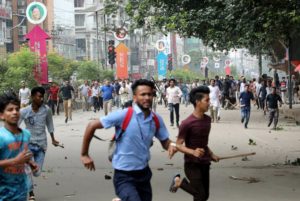By Kamran Reza Chowdhury on Aug 05, 2018
2018-08-05
Bangladeshi police clashed with students for a second day in a row on Sunday, leaving dozens of people injured, witnesses and local media said, as the U.S. Embassy in Dhaka confirmed that a group of armed men attacked an official car carrying Washington’s envoy as it drove through a Dhaka neighborhood
The latest burst of violence took place hours after authorities shut down mobile internet service in the nation, in what critics described as the government’s bid to control the protests that began last weekend after two teenagers were killed by a speeding bus.
The U.S. Embassy in Dhaka said “a group of armed adult men,” including some on motorcycles, attacked while Amb. Marcia Bernicat’s convoy drove through the city’s Mohammadpur residential block before midnight Saturday.
“The ambassador and her security team departed the area unharmed,” said the statement, which was published on the embassy’s website Sunday. “However, two security vehicles sustained some damage.”
Badiul Alam Majumder, a prominent local activist and government critic, told BenarNews that the attack happened around 11 p.m. as Bernicat and her convoy left a dinner party at his home.
“As the ambassador was leaving my house, some youths on motorcycles attempted to attack her,” Majumder said. “They threw bricks at her vehicle.” But the car carrying the diplomat quickly left the area, he said.
Local media reported that at least 50 people were injured in clashes Sunday. Witnesses said police fired tear gas and also arrested dozens of demonstrators.
After violence subsided on Sunday, Home Minister Asaduzzaman Khan warned that the government would not tolerate what he described as “anarchy” in the pretext of protest.
“We have shown patience. Our law-enforcing agencies have been showing patience,” he told BenarNews. “But this does not mean anarchy would be tolerated. We will be forced to take action if the limit exceeds.”
Violent confrontation first broke out on Saturday after police and men allegedly linked with the ruling party swooped in and chased the demonstrators with long sticks, injuring more than 100, according to the news agency AFP, which quoted hospital officials and witnesses.
The ruling Awami League party rejected allegations its cadres were involved in the violence.
On Sunday, tens of thousands demonstrators defied Prime Minister Sheikh Hasina’s warning that a third party could sabotage the massive protest.
Her statement came as pro-government activists belonging to a political youth league attacked several journalists, according to the Associated Press.
Up to 26 journalists suffered injuries while covering two days of violence, according to a BenarNews tally. Among them was AP news photographer AM Ahad, seen in a Dhaka Tribune photograph while at a Dhaka hospital’s emergency room, where he was briefly treated for a head injury.
Social media videos of Ahad’s attack showed about a dozen men striking him with long sticks and batons as he stumbled and retreated in one corner.
Hasina, who has ruled the nation since January 2009, has reached out to the protesters by promising to improve road safety. But she said that a “third party” could sabotage the spontaneous protests, which came as her government started gearing up for a general election scheduled in December.
“That’s why I request all guardians and parents to keep their children at home. Whatever they have done is enough,” Hasina, 70, told reporters, without elaborating.
The eighth day of what appeared to be an unorganized protest kept the nation’s capital grounded to a halt as thousands of students, many of them younger than 18 and wearing school uniforms, prevented transit through much of Dhaka, essentially cutting off the city from the rest of the country.
Exposing nation’s road safety weaknesses
Thousands of students began pouring into the streets eight days ago as they chanted slogans and demanded improvements in road safety in Bangladesh, a South Asian nation of 163 million people with one of the world’s highest death rates from road crashes that safety analysts blame on speeding buses.
In 2016, at least 6,055 people were killed in road accidents around the country, the Bangladesh Passengers Welfare Association said. During the previous year, more than 8,600 people lost their lives on the nation’s roads, it said.
The students exposed the nation’s transportation weaknesses during their protests, as they stopped vehicles, including a cabinet member’s car and police officers on motorcycles, asking them to present their driver’s licenses.
Social media videos and photographs showed the students striking some buses with rocks and setting at least one on fire after it allegedly struck a motorcyclist. Local newspapers said bus drivers refused to work as they expressed fears over the huge crowds of angry students who blocked major roadways.
In an effort to quell the protests, the government suspended classes in high schools on Thursday and shut down 3G and 4G internet services two days later, starting after the first bout of violence on Saturday, local newspapers and news agencies said.
“The BTRC has slowed down the internet at the order of the government,” a senior official told Agence France-Presse, referring to the Bangladesh Telecommunications Regulatory Commission (BTRC).
The news agency also quoted BTRC chairman Jahirul Haq as saying that the government has issued a “decision,” but he declined to clarify.
Meanwhile, as violence took place in Dhaka, about 35 men forcibly abducted award-winning photographer Shahidul Alam from his home in the city’s Dhanmondi residential area hours after he posted pictures about the protests on his Facebook page, according to local reports and a statement issued by his multimedia company.
Alam “was screaming as he was pushed into a waiting car” by the men who said they were from the detective branch of the Dhaka police, according to a statement emailed by Amina Neyamat, communications officer at Drik and Pathshala Media Institute, which was founded by the famed photographer.

